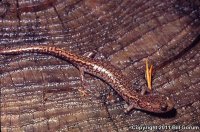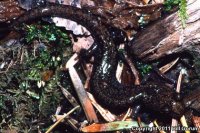| Range: |
 Endemic to south-central New Mexico where it is found in the Capitan, White and Sacramento Mountains of Lincoln and Otero counties. Endemic to south-central New Mexico where it is found in the Capitan, White and Sacramento Mountains of Lincoln and Otero counties. |
| Other Names: |
|
| Description: |
Aneides hardii is blackish brown to brown dorsally and is often heavily mottled with greenish gray to bronze; the venter is light in color. Tail length averages slightly shorter than the body length. There are 14-15 costal grooves. The limbs are short with 2-4.5 costal folds between the toe tips of the adpressed limbs. The digits are short and only slightly expanded distally. The head is somewhat triangular when viewed from above, with the temporal region slightly swollen by the jaw musculature, especially in mature males. Mature males average 48.4 mm (1.9") SVL; females 44.5 mm (1.75"). Hatchlings resemble the adults and first appear on the surface at approximately 15 mm (.59") SVL. |
| Habitat: |
Aneides hardii is generally associated with Douglas Fir and spruce at elevations from 2400-3570 m (7874-11712') where it is usually found under large woody debris or rocks. |
| Behavior: |
Active on the surface from mid-June to mid- to late September, although most activity occurs during summer rains in July and August. |
| Hibernation: |
|
| Reproduction: |
Mating occurs in early June and probably takes place underground. They produce one of the smallest clutches of eggs known among salamanders. |
| Diet: |
Various arthropods and other invertebrates are eaten including annelid worms, mollusks, collembolans, beetles, ants and small wasps. |









